#song is the credits from smtIV apocalypse
Text

still life! working on my colours and edges. you can see me fighting for my life below to the soothing sounds of Skeleton Music. i'd guess at a colour, swatch it over the reference picture, get that wrong, repeat until correct. it's slow-going, but i feel like progress is being made
#timelapse#rochedotpng#when i get back to those old men.... it will be with renewed vigour#although i suppose you could call this man very very old. too old even#song is the credits from smtIV apocalypse#flashing lights cw#god almighty i hate painting teeth. we have too many bones! too many! it's greedy!
164 notes
·
View notes
Text
Persona 4 Golden and the Problem of Appealing to a Wider Audience
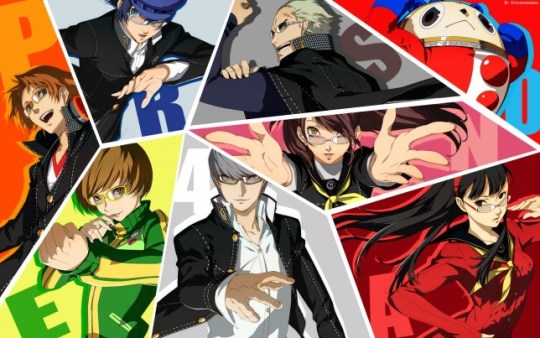
I’ve been questioning how to go about writing this essay ever since I first finished Persona 4 Golden back in 2013. When I first finished the game, I came out of it not liking it very much – mechanically, it felt unbalanced; and writing-wise, I found it poorer than its original. My opinions on the game have shifted somewhat since then, helped along by the release of Persona 5 and the realization that many of the game’s mechanics were testbeds for that game. However, with time, I’ve found that I can articulate a lot of the problems Golden has with its writing a lot better. What I’ve ultimately settled on is looking at the Persona 4 we were originally given, then looking at its rerelease, and seeing what changed there and why I didn’t like it. Let’s jump in, shall we?
(Note: There will be complaining about Marie. My opinions on that subject sure as hell haven’t changed in the past seven years. Also, there will obviously be spoilers.)
I. A Brief History of Persona 4 as a Franchise
Shin Megami Tensei: Persona 4 (later spinoffs would drop the subtitle) released in the west in 2008 as a follow-up to the very strange (at the time) and very niche Shin Megami Tensei: Persona 3. Persona 3 was notable for deciding to go for an urban setting, an avant-garde aesthetic, and heavy philosophical themes, something that was rare for RPGs before 2010 (though not for its own franchise). While Persona 4 kept the philosophical focus of Persona 3, it decided to dial back some of the artsier aspects in favor of a more down-to-earth, focused story. Where P3 told a story about the inevitability of death and took place in a very modern Japanese setting, P4 decides to tell a story about the lies we tell ourselves and takes place in a rustic, rural setting.
Some of the first things that Persona 4 tells you after getting to its setting, Inaba, are that the town really only has one tourist attraction, it’s far from anywhere of real note, and its local businesses are all being driven out of business by the construction of a corporate superstore. It’s relatable, particularly to anyone who’s watched their local mom-and-pops go out of business after a Wal-Mart decided to move in.
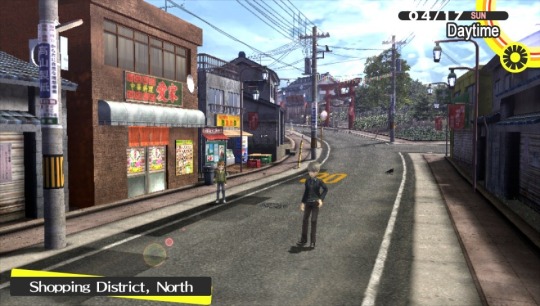
The tone of this setting permeates through Persona 4 – all of its characters are pretty down-to-earth, and though there’s some cartoonish exaggeration in their writing, they feel more like real people than your average RPG character. Yosuke is the new kid in town who struggles with feelings of inferiority, something that’s not helped by his dad running the superstore that’s driving everyone out of business. Naoto is a girl with aspirations of becoming a detective, but hides her gender out of a belief that if she does so, she’ll be taken more seriously by the male-dominated police force. Even the game’s idol character, Rise, is someone who quit the business because the pressures of the idol industry became too much for her. Most games would take the opportunity to have an idol character written into the cast as an excuse for a pandering song and dance sequence and to play up her “waifu” aspects. Persona 4 spends the first hour after Rise’s introduced having her in and apron and slacks, serving tofu, and dodging paparazzi.
Persona 4 is not perfect in how it approaches its characters – in particular, Kanji and Naoto’s storylines have gotten a deserved level of flack for having essentially written coming-out stories for a gay man and a transman, and then immediately backing off and “no homo”-ing them. There’s a number of Social Links that end with the character deciding to go do the socially acceptable thing for them to do instead of following their own hearts, too – Yukiko’s comes to mind. But the character conflicts and stories told in the game’s Social Links are grounded and relatable.
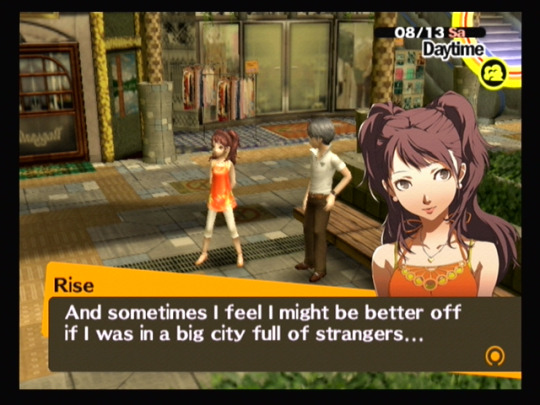
The grounded-ness of Persona 4 was what really made it stand out in 2009, a time where RPGs and games as a whole were mostly concerned with showing off the cool things they could do with their engines (keep in mind, this was the early era of the PS3, and Persona 4 was a PS2 game). Looking back, it’s easy to realize that Persona 4 was made as grounded and rustic as it was because of budgetary concerns, but what was done with its limited budget was incredible. It looked at its setting and tone and embraced them, and that helped to make the game stronger.
And it worked! Persona 4 was easily Atlus’s biggest success in the PS2 era. Though the game was hard to find in the United States due to its short print run, it was inescapable online, and the early Let’s Play era helped keep it in the public eye. There’s a large number of people in the English fandom who only knew Persona 4 existed back in the day because of the hiimdaisy comic and the Giant Bomb Endurance Run. Meanwhile, the game was huge in Japan and topped sales charts for weeks.

Source: Gamasutra
And then Atlus almost went out of business! Oops!
Here’s what we know about Atlus at the time that Persona 4 came out: it wasn’t doing good. The PS2 Shin Megami Tensei games were all desperate attempts to try and find success, something that Persona director Katsura Hashino has been fairly public about in interviews. Dataminers examining the PS2 SMT games have found evidence that suggests every game was built on top of the previous, with every game using SMT: Nocturne’s models and basic gameplay system until after Persona 4’s release. Persona 3 and Persona 4 are so similar under the hood that model swap mods are everywhere for the two, with literally the only adjustments necessary being a reordering of animations to account for Persona 4 having a guard animation and Persona 3 not.
Persona 4 was a huge hit, but it wasn’t enough to save Atlus. The last games released under an independent Atlus were Shin Megami Tensei: Devil Survivor (one of my personal favorites) and Shin Megami Tensei: Strange Journey (a massive failure for the company). Following Strange Journey’s release, long-time franchise artist (and, more importantly, producer and creative designer for Strange Journey) Kazuma Kaneko near entirely disappeared from future SMT titles, only credited for writing the scenario concept for SMTIV and as a demon design supervisor for later SMT titles.
Soon after Strange Journey’s failure, Atlus was snatched up by Index Corporation. Very little is known about the internal culture during the Index era, but evidence suggests that it wasn’t great. The first few games Atlus produced after this point were all remakes, save for the strange, marriage-drama focused Catherine, a game that was assuredly in development before Atlus was bought out.
It was the original games and spinoffs that Atlus produced after they were bought by Index that started to show a shift in tone. Devil Survivor 2 is a notably different game than its predecessor (which was made while Atlus was independent). While I won’t get into that too much here (that game’s worth an essay on its own), it decided to trade it’s classical SMT-style aesthetic for something more bombastic and widely-appealing. Many of the characters in that game are better summed up by what anime tropes they appeal to than by their own character arcs, and the game’s plot is an unsubtle ripoff of Neon Genesis Evangelion. And it worked. Devil Survivor 2 very notably sold better than its predecessor despite being a DS game in the 3DS era.
At around the same time as Devil Survivor 2 was released, Atlus was preparing to release the first anime adaptation of Persona 4. Persona 4: The Animation was released in October of 2011, directed by Seiji Kishi (of Angel Beats! fame) and animated by AIC. I’ll leave my thoughts on Seiji Kishi as a director out of this and focus on the content of Persona 4: The Animation instead.
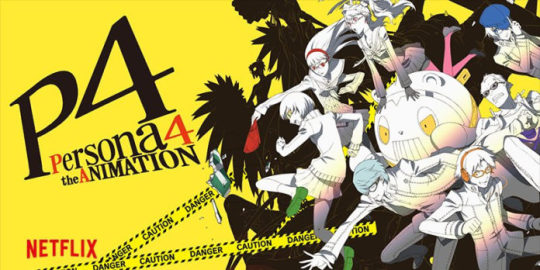
Let’s get one thing out of the way. Persona 4: The Animation is a comedy anime.
The anime is a fairly faithful adaptation of the game in terms of plotline. It follows the game’s story to the letter, hitting every plot beat. When it needs to get serious, it gets serious, and when it nails its emotional beats, it nails them well. While I’ll go on record in saying that I flat out dislike the anime, I won’t deny that certain episodes, like the Nanako arc, are done very well. However, when it doesn’t need to be serious, the anime decides to look at Persona 4’s subtlety in its character arcs, and says, “Subtlety is for cowards.”
There’s an argument to be made that there isn’t time for subtlety in a 24-episode anime, which is why everyone’s character arcs needed to be compressed and character traits shaved down to only the most exaggerated bits. I disagree. You can easily show character without exaggeration in short-form media – the entire short story genre is built off of that exact concept. The decision to shave everyone down to their most basic traits was a decision made to make Persona 4 more accessible to a general anime-watching audience, who likely came in expecting a more action-packed, high energy deal.
And it worked.
For many people, Persona 4: The Animation was their first experience with Persona, period. The anime was incredibly popular, and it’s clear that at this point, Atlus (or, more likely, Index) realized they’d struck gold. Persona 4: The Animation was the start of a large spate of Persona 4 spinoffs, all of which adopting the character exaggerations of the anime in some form or fashion. Any time you see a scene in a P4 spinoff where Chie’s reduced to her love of meat and kung-fu? Blame the anime. Further original games after this point seemed to take a more mainstream shift as well – Shin Megami Tensei IV and its sequel, Apocalypse, are both very different games than their predecessors, with characters and plotlines seemingly written to appeal to Persona 4’s audience.
Atlus eventually managed to claw their way out from under the hand of Index, mostly because Index got caught up in a huge fraud investigation! Oops! Sega bought a whole bunch of Index at this point, and Atlus has more or less kept on trucking under Sega since. However, the shift in internal priorities hasn’t changed much – Persona 5, while still a good game, is much closer tonally to the games that came out under Index, Shin Megami Tensei V has been AWOL ever since its first preview, and the less said about Catherine Redux, the better.
II. Less is More, and Maybe Inaba Doesn’t Need A Nightclub
Which, after a long detour, brings us back to Persona 4 Golden.
Golden is a remake of Persona 4 with additional content, released for the Playstation Vita (RIP) during the height of its popularity in Japan. Like Persona 3 FES, a previous patch/remake for Persona 3, Golden primarily exists as a gameplay patch to Persona 4 with additional story content in places throughout the game. While most of FES’s additional story was segmented off into the controversial “The Answer” section, Golden’s additional content is peppered haphazardly throughout the game. Because of this integration into the main story, Golden’s issues are more pronounced than FES’s were – in FES, you could just not play “The Answer”. Golden isn’t letting you go home without at least pushing you toward Marie’s dungeon.
Golden feels like it was developed with an understanding that anyone who’s playing it has watched the anime, and decides to lean into chasing that mainstream appeal while also throwing out the intrigue of its plot and setting. This is first evidenced when you boot up the game and watch the opening. While it hits all of the same beats as Persona 4’s opening, Golden’s opening has a much cheerier tune to it, focusing on a dance sequence and colorful visuals instead of the larger tone of the game. It’s not like the Persona 4 opening is completely absent from the game, but you have to go out of your way to watch it, and first impressions are very important.
This change in opening tone is only one example of the general tone of the changes that Golden takes. While there are big issues with the game’s writing (specifically one big one, which, whooo boy, we’ll get to her), most of the issues are in the little things – the new gameplay elements, the new areas you can visit, and the new scenes that were added to the game.

I talked a lot about how important P4’s setting is to its game for a reason: most of Golden’s changes are ones that disrupt the carefully crafted tone and setting of the original game. From things like slice of life scenes about the party buying scooters for themselves, to a winter trip to a ski resort, to a goddamn idol concert on the roof of the supercenter driving everyone out of business, it feels like the game is trying to pull away from its rural setting and down-to-earth tone to appeal to the lowest common denominator: teenage boys who live in Japanese cities.
A big sticking point for me personally has always been that you can visit Okina City in Golden. In Persona 4, you visited the nearby city occasionally in social link events, but never explored it on the whole. It gave a sense that Okina City was somewhere inconvenient to go to – someplace worth going to for a day trip with your friends, but too out of the way to visit on the regular. In Golden, the city and all of its trappings are just a loading screen away. Having a larger setting change like this so easily accessible detracts from Inaba’s setting – it makes the anxieties that several characters have about being trapped by the town feel fake. It detracts from a feeling that’s so integral to the game’s tone.
Also, the first time you go there outside of a Social Link is because Yosuke wants to pick up chicks with his cool new motorcycle.
The first trip to Okina City is ultimately indicative of a larger problem with most of the added scenes in P4G have: because they were written after the anime, they’re written to appeal to anime watchers. You can immediately tell when you’ve entered a scene that is original to P4G because the writing almost immediately drops in quality – characters become less complex, scenes have nothing to do with the plot or character development, and, to be quite honest, the jokes get worse. The Okina City sequence ultimately just ends with a fat joke and another “no homo” moment with Kanji. It’s… really bad.
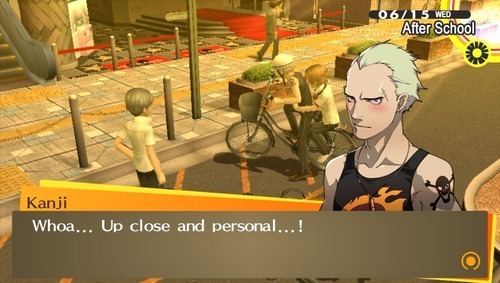
There’s four more of these additional sequences throughout the game, and they’re all similar slice of life sequences that rely on anime tropes to propel them. The next after this is a beach episode with the rest of your party. After that is the idol concert on the Junes roof, which gets a hastily written tie-in to the plot when an antagonist says that the concert was how he found the party. After that is the entire winter sequence of the game, which caps off with a ski resort trip that leads into the game’s extra dungeon (which we’ll get to), which THEN leads into the game’s second hot springs cutscene, which has even less purpose than the first one.
None of these scenes have any real substance – it feels like they were just included because they actually had the budget to include them this time around. It’s possible that Okina City and the nighttime areas in Inaba were originally intended for the original version of P4, and I’d believe it – the way nighttime jobs are implemented in the original version of the game is particularly awkward, and you visit Okina City enough times in Social Links that I fully believe it was intended for the full game. As for the idol concert sequence, it 100% only exists because they got Rie Kugimiya as Rise’s VA, but couldn’t fit a sequence where she sang into the original version of the game.
The problem is that these inclusions ultimately detract from the original story. They take a game with a pretty firm idea of what kind of tone it wanted to have and muddle it because, fuck that, we have a budget this time and we need more anime tropes, idols, and tsunderes for those kids who came in after watching the anime.
Which brings us to Persona 4 Golden’s biggest issues: its additional Social Links, the winter semester, and its new ending sequence.
III. We have to talk about Marie.
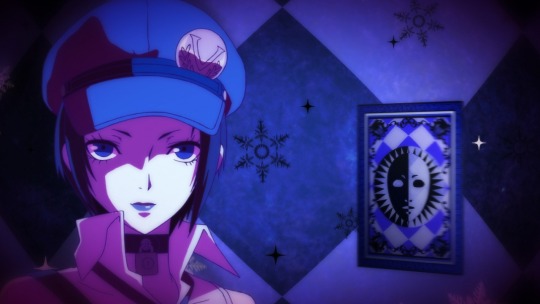
Like Persona 3 FES before it, Persona 4 Golden adds new Social Links to the game. The first of which is the Jester Social Link, which deals with Tohru Adachi, a local police officer and a major character. While I’ve never been a huge fan of this Social Link (I’ve always felt like it made the identity of the culprit too obvious), it’s fairly well received by the fanbase and I can see the argument for its inclusion, so I’m not going to spend time discussing it here.
The other is Golden’s new Aeon Social Link, who manages to encompass most of Golden’s issues in a single character.
Marie is a completely original character to Golden, the first of a long chain of Atlus “remake waifus” – characters who are added to a remake of a game that are intended to appeal to the otaku crowd, rarely fit in with the rest of the game, and introduce large changes to the game’s plot. These characters rarely work because the narrative wasn’t built around them, and the retcons these characters introduce are often detrimental to their games’ original plots or themes.

Marie has all of these problems. She feels like she was written by committee – designed to appeal to an otaku crowd with a fancy design and tsundere personality. On top of that, she’s voiced by a big name seiyuu (Kana Hanazawa), and her plotline is used to fill in gaps with the game’s ending sequence, since the original game struggled with setting it up and the anime barely even bothered to touch it (Persona 4’s True Ending was shuffled off into an OVA in the anime adaptation).
From the moment you first see Marie, it’s obvious that she doesn’t belong. It’s not that her character design is bad, but it doesn’t match with the rest of the game’s tone. This is something of a pattern for her. The first time you meet Marie, it’s in the middle of a scene that was originally dedicated to the protagonist meeting his new family in Inaba. It’s jarring, disrupts a scene that was about setting up the protagonist’s larger family dynamic, and interrupts the flow of the game’s opening sequence.
Personality-wise, Marie is probably the most tropey of Golden’s characters – she’s a tsundere with amnesia, has a mysterious past, writes bad poetry as a hobby, and has a very obvious crush on the protagonist. Romancing her is almost mandated – you’re required to complete her Social Link to access the winter semester of the game, and during the game’s new ending, she calls out the protagonist on television to talk about how much she loves him. You can choose not to romance her if you want, but the game does its best to push you into wanting to do so.

Marie ultimately becomes one of the Velvet Room’s new attendants, though a lot of the evidence suggests that she was intended to become one of your party members originally. This is partially because she has a unique Persona related to her, and partially because the game takes every effort to emphasize how much of a buddy she is to the party. Marie’s Social Link ranks are time gated, usually becoming available after a new party member joins your team. All of these early scenes are dedicated to the protagonist going on dates with Marie, and then a random party member will show up and immediately become friends with her. Probably the most egregious case is during any mid-game hangouts where you don’t rank up, because the entirety of your party will just show up at Junes at the same time as you and Marie. It’s so obviously artificially constructed and honestly feels insulting to the player.
This artificiality feels like it was a writer’s saving throw to justify why the team would go into Marie’s dungeon to save her. The problem is that it’s also an unnecessary move to take. The majority of Persona 4’s plot is about the party entering dungeons to save people that they don’t really know from a serial killer; it stands to reason that the party would decide to help Marie without that extra motivation. But no, it was important to the writers that Marie is also big friends with the party, so we got what we got instead.
Marie’s dungeon comes after the skiing trip that caps off the winter semester, a portion of the game that is only available if you’ve finished her Social Link. The skiing trip is mostly more slice of life/comedy scenes, right up until you get thrust into the TV World to help Marie. The dungeon itself is… notoriously bad. You’re stripped of your equipment and items, and can only use items found within the dungeon to fight back. On top of that, the dungeon constantly drains your HP and MP, and the boss of it can only be damaged by using items that give her elemental weaknesses, because she starts off immune to everything. Here’s hoping you didn’t bring Chie for that fight like I did!
As you go through the dungeon, it’s revealed that Marie was secretly Kusumi-no-Okami, a minor Shinto god in service to Ameno-Sagiri (the game’s first final boss). Kusumi-no-Okami’s purpose is that she’s supposed to observe humanity and suck up all of Ameno-Sagiri’s fog after the conclusion of the game’s plot, which will inevitably kill her. The dungeon ends with the party trying to appeal to Marie to convince her that she doesn’t need to die, and then beating her up to save her. It’s… not particularly well written, but if that was all to Marie’s character after that, it would be fine. Unfortunately, it’s not.
The game proceeds as normal after that point as you approach the actual final boss, Izanami-no-Okami. During the fight with her, there is a sequence where the protagonist is encouraged to keep going by all of his social links. In the original version of the game (assuming that you’ve done their Social Links), this sequence ends with Dojima and Nanako, the family he’s been staying with the whole game, encouraging him to keep going. In Golden, Nanako’s line is immediately followed by Marie showing up, once again taking a sequence about familial love to make it about Marie. It’s… kind of gross!

Then you beat Izanami, and in the scene immediately afterwards, it’s revealed that, just kidding, Marie wasn’t Kusumi-no-Okami after all! She was actually Izanami-no-Mikoto, the good part of Izanami that was shaved off so that she could do her whole evil plot. Once you beat Izanami-no-Okami, she absorbs that evil part back into her and everything is all hunky dory! Conflict resolved completely, no need to worry about it anymore!
The “Marie was actually Izanami all along” reveal undercuts the finale of the game significantly. It comes immediately after what was the final scene before the ending scene, where Izanami pledged to leave humanity’s direction to humans in recognition of your feats. It’s an unnecessary doubling down on a finale that was already pretty definitive, if somewhat bittersweet, by making it unambiguously happy. This remains a theme for Golden’s ending sequence.
Persona 4 ends with the protagonist leaving his friends behind at the end of the year. Though the killer is in jail and the mastermind defeated, Inaba is still in the same melancholy state as it was when the protagonist came to it, and ultimately, he has to leave his friends behind. There’s a bittersweet-ness to its happy ending – no matter what, you have to move on and trust that things will be okay without you. Obviously, the protagonist comes back – there wouldn’t be so many spinoffs if he couldn’t – but it’s important that Persona 4 ends the way it does at that point. It puts a definitive close on the game.

Golden, however, adds an extended epilogue sequence where the protagonist comes back a year later. In this sequence, you find out that Inaba’s businesses are recovering, Namatame (the false antagonist) is running for office with a lot of support from the town, Adachi (the actual antagonist) has been on good behavior in jail, and your party members are all making tracks toward happiness for themselves.
A theme of esoteric happiness runs through this entire sequence – it feels like it entirely exists just to tell the player not to worry, everything is fine now, don’t worry about any other points of conflict. If it was just one of these things, it would have been fine, but the gatling gun of happy endings makes every one of those little victories feel lesser for it. Marie, of course, is inserted into the ending sequence of the epilogue to cap off her involvement. The esoteric happiness started with Marie, and it ends with Marie.
Golden’s epilogue ties every conflict in the game up into a neat little bow, in a way that’s almost entirely at odds with Persona 4’s down-to-home nature. It’s a fantasy that doesn’t acknowledge the uglier parts of life that Persona 4 was all about confronting. It’s the same kind of lie that Izanami accused humanity of wanting to nestle itself into. Marie’s involvement in Golden sums up a lot of that game’s problems, but the epilogue brings them into sharp relief.
IV. So now what?
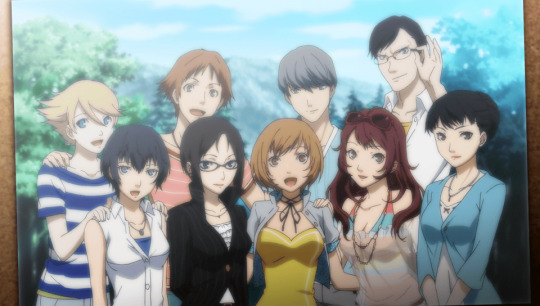
I wouldn’t call Golden a bad game – I’ve heard a lot of people call it the superior version gameplay-wise, and while I disagree with that (it’s got some balance issues thanks to its new mechanics), it’s definitely the most accessible version. But when it comes to how it relates to its original, Golden throws a lot of what makes it good out the window in favor of appealing to a more general audience with slice of life sequences, more familiar tropes, and a character who mostly exists to sell merchandise and tie up Persona 4’s ending in an unambiguously happy manner.
I realize I’m in the minority here when I talk about what I dislike about Golden – you’ll find a lot of people who dislike Marie, but not a lot who dislike the rest of the package. And if you have a Vita and haven’t played Persona 4 already, then you might as well use it as your entry point into the franchise. However, I can’t help but feel like Golden is the exact point where Persona as a franchise shifted from trying to tell philosophical stories with more grounded characters to chasing mainstream appeal. Even Persona 5, a game that tries to tell a story about very real societal problems, has a lot of the same problems as Golden does, and from what I understand, these problems only got worse with Persona 5 Royal.
At the end of the day, Persona is going nowhere anytime soon – Persona 5 is the best-selling game in the franchise period, and the influence Persona has had on JRPGs in general cannot be understated. But I wouldn’t mind if some of the things I disliked about Persona 4 Golden didn’t come back.
66 notes
·
View notes